Design of an Architectural Element Generating Hydrogen Energy by Photosynthesis—Model Case of the Roof and Window
Abstract
1. Introduction
2. Materials and Methods
2.1. PSII-Containing Solution
2.2. Collagen Electrolyte Fuel Cell
2.3. Measurement of Light Intensity and Temperature
3. Results and Discussion
4. Conclusions
Author Contributions
Funding
Institutional Review Board Statement
Informed Consent Statement
Data Availability Statement
Conflicts of Interest
References
- FAO. Global Food Losses and Food Waste: Extent, Causes and Prevention; FAO: Rome, Italy, 2011. [Google Scholar]
- Raak, N.; Symmank, C.; Zahn, S.; Aschemann-Witzel, J.; Rohm, H. Processing- and product-related causes for food waste and implications for the food supply chain. Waste Manag. 2017, 61, 461–472. [Google Scholar] [CrossRef] [PubMed]
- Sorensen, B. Hydrogen and Fuel Cells; Elsevier Academic Press: Amsterdam, The Netherlands, 2005. [Google Scholar]
- Kleijn, R.; van der Voet, E. Resource constraints in a hydrogen economy based on renewable energy sources: An exploration. Renew. Sustain. Energy Rev. 2010, 14, 2784–2795. [Google Scholar] [CrossRef]
- Jacobson, M.Z.; Delucchi, M.A. Providing all global energy with wind, water, and solar power, Part I: Technologies, energy resources, quantities and areas of infrastructure, and materials. Energy Policy 2011, 39, 1154–1169. [Google Scholar] [CrossRef]
- Hayat, M.B.; Ali, D.; Monyake, K.C.; Alagha, L.; Ahmed, N. Solar energy—A look into power generation, challenges, and a solar-powered future. Int. J. Energy Res. 2018, 43, 1–19. [Google Scholar] [CrossRef]
- Veers, P.; Dykes, K.; Lantz, E.; Barth, S.; Bottasso, C.L.; Carlson, O.; Clifton, A.; Green, J.; Green, P.; Holttinen, H.; et al. Grand challenges in the science of wind energy. Science 2019, 366, eaau2027. [Google Scholar] [CrossRef]
- López, I.; Andreu, J.; Ceballos, S.; Martínez de Alegría, I.; Kortabarria, I. Review of wave energy technologies and the necessary power-equipment. Renew. Sustain. Energy Rev. 2013, 27, 413–434. [Google Scholar] [CrossRef]
- Uihlein, A.; Magagna, D. Wave and tidal current energy—A review of the current state of research beyond technology. Renew. Sustain. Energy Rev. 2016, 58, 1070–1081. [Google Scholar] [CrossRef]
- Kaunda, C.S.; Kimambo, C.Z.; Nielsen, T.K. Hydropower in the Context of Sustainable Energy Supply: A Review of Technologies and Challenges. ISRN Renew. Energy 2012, 2012, 730631. [Google Scholar] [CrossRef]
- Soltani, M.; Kashkooli, F.M.; Dehghani-Sanij, A.R.; Nokhosteen, A.; Ahmadi-Joughi, A.; Gharali, K.; Mahbaz, S.B.; Dusseault, M.B. A comprehensive review of geothermal energy evolution and development. Int. J. Green Energy 2019, 16, 971–1009. [Google Scholar] [CrossRef]
- Tursi, A. A review on biomass: Importance, chemistry, classification, and conversion. Biofuel Res. J. 2019, 22, 962–979. [Google Scholar] [CrossRef]
- Patle, S.; Lal, B. Ethanol production from hydrolysed agricultural wastes using mixed culture of Zymomonas mobilis and Candida tropicalis. Biotechnol. Lett. 2007, 29, 1839–1843. [Google Scholar] [CrossRef] [PubMed]
- Show, K.-Y.; Lee, D.-J.; Chang, J.-S. Bioreactor and process design for biohydrogen production. Bioresour. Technol. 2011, 102, 8524–8533. [Google Scholar] [CrossRef] [PubMed]
- Matsuo, Y.; Kumasaka, G.; Saito, K.; Ikehata, S. Fabrication of solid-state fuel cell based on DNA film. Solid State Commun. 2005, 133, 61–64. [Google Scholar] [CrossRef]
- Matsuo, Y. Bio-Fuel Cell Based on Biopolymer Electrolyte. J. Fuel Cell Technol. 2014, 13, 60–63. [Google Scholar]
- Matsuo, Y.; Ikeda, H.; Kawabata, T.; Hatori, J.; Oyama, H. Collagen-Based Fuel Cell and Its Proton Transfer. Mater. Sci. Appl. 2017, 8, 747–756. [Google Scholar] [CrossRef][Green Version]
- Kawabata, T.; Matsuo, Y. Chitin Based Fuel Cell and Its Proton Conductivity. Mater. Sci. Appl. 2018, 9, 779–789. [Google Scholar] [CrossRef]
- Matsui, H.; Matsuo, Y. Proton Conduction via Water Bridges Hydrated in the Collagen Film. J. Funct. Biomater. 2020, 11, 61. [Google Scholar] [CrossRef]
- Furuseki, T.; Matsuo, Y. Fuel Cell Using Squid Axon Electrolyte and Its Proton Conductivity. J. Funct. Biomater. 2020, 11, 86. [Google Scholar] [CrossRef]
- Takahashi, Y.; Iwahashi, A.; Matsuo, Y.; Kawakami, H. Solid-State Hydrogen Fuel by PSII–Chitin Composite and Application to Biofuel Cell. J. Compos. Sci. 2021, 5, 317. [Google Scholar] [CrossRef]
- Iwahashi, A.; Yamada, T.; Matsuo, Y.; Kawakami, H. Novel Biofuel Cell Using Hydrogen Generation of Photosynthesis. J. Funct. Biomater. 2020, 11, 81. [Google Scholar] [CrossRef]
- Algae-Filled Walls—“Green” Wall Powering a Green Building. Available online: https://dodosustainabilityjournal.wordpress.com/2016/03/19/algae-filled-walls-green-wall-powering-a-green-building/ (accessed on 16 April 2022).
- Ono, A.; Kimura, Y.; Kosugi, H.; Takegami, H.; Nakano, S.; Matano, S.; Metoku, K.; Yoshizawa, S.; Tsutsumi, T.; Sugiyama, A.; et al. Architectural Model “Oasis”, Setsunan University Brochure 2023; Setsunan University Press: Neyagawa, Japan, 2022. [Google Scholar]
- Available online: Iwahashi, A.; Takahashi, Y.; Furuseki, T.; Kawabata, K.; Teranishi, S.; Gotouda, Y. Production of “Hommage à l’écran de photosynth”se Eileen Gray" 2020. Available online: https://xtech.nikkei.com/atcl/nxt/column/18/00154/00846/ (accessed on 16 April 2022).
- Philippe, B. Eileen Gray Designer and Architect; Benedikt Taschen: Cologne, Germany, 1993; 48p. [Google Scholar]
- Kawakami, H. The Design Methods of Eileen Gray in the Minimum House E.1027: Through the Analysis of Four Style Manipulation. Bull. Jpn. Soc. Sci. Des. 2004, 6, 57–66. [Google Scholar]
- Kawakami, H.; Matsuo, Y. Beautiful Renewable Energy; Impact-Advancing Technology: Bristol, UK, 2020; p. 39. [Google Scholar]
- Nugent, J.H.A.; Rich, A.M.; Evans, A.M. Photosynthetic water oxidation: Towards a mechanism. Biochim. Biophys. Acta 2001, 1503, 138–146. [Google Scholar] [CrossRef]
- Johnson, M.P. Photosynthesis. Essays Biochem. 2016, 60, 255–273. [Google Scholar] [CrossRef] [PubMed]
- Ort, D.R.; Yocum, C.F. Light reactions of oxygenic photosynthesis. In Oxygenic Photosynthesis; Ort, D.R., Yocum, C.F., Eds.; Kluwer Academic Publishers: Amsterdam, The Netherlands, 1996. [Google Scholar]
- Shen, J.-R.; Enami, I. Isolation of photosystem II. Low Temp. Sci. 2009, 67, 275–283. [Google Scholar]
- Miyao, M. Isolation of intact chloroplasts, thylakoids and photosystem II membranes from higher plants. Low Temp. Sci. 2009, 67, 197–203. [Google Scholar]
- Liyu Zhu, L.; Li, Y.; Zhao, J.; Liu, J.; Wang, L.; Lei, J.; Xue, R. Enhanced proton conductivity of Nafion membrane induced by incorporation of MOF-anchored 3D microspheres: A superior and promising membrane for fuel cell applications. Chem. Commun. 2022, 58, 2906–2909. [Google Scholar]
- Gebhart, B. Heat Conduction and Mass Diffusion; McGraw-Hill Inc.: New York, NY, USA, 1993; 620p. [Google Scholar]
- George, W. Handbook Polymers for Electronics; Elsevier: Amsterdam, The Netherlands, 2021. [Google Scholar]
- Viljoen, N. Environment, Energy and Water Sustainability Report of Anglo Platinum Limited Annual Report; Anglo Platinum Limited: Marshalltown, South Africa, 2010. [Google Scholar]
- Worrell, E.; Phylipsen, D.; Einstein, D.; Martin, N. Energy Use And Energy Intensity of the U.S. Chemical Industry; Energy Analysis Department, Ernest Orlando Lawrence Berkeley National Laboratory, University of California: Berkeley, CA, USA, 2000. [Google Scholar]
- Staffell, I.; Ingram, A.; Kendall, K. Energy and carbon payback times for solid oxide fuel cell based domestic CHP. Int. J. Hydrogen Energy 2012, 37, 2509–2523. [Google Scholar] [CrossRef]
- Babu, A.R.V.; Rao, G.; Kumar, P.; Saranu, S.; Babu, A.; Uma, C.; Rao, M.; Teja, A.J.R.R. Energy and Green house gas Payback Time analysis of an Air Breathing Fuel Cell Stack. J. Electr. Eng. 2015, 15, 52–61. [Google Scholar]
- Ito, M.; Masuda, Y.; Nagai, K. Evaluation of long-term stability and degradation on polycarbonate based plastic glass. J. Polym. Eng. 2015, 35, 31–40. [Google Scholar] [CrossRef]
- Tanimoto, K.; Yasuda, K.; Siroma, Z.; Akita, T.; Kobayashi, T. Durable polymer electrolyte fuel cells (PEFC) for residential co-generation application. Synthesiology 2012, 5, 53–61. [Google Scholar] [CrossRef][Green Version]
- Power Generation Efficiency and Durability Raised to Commercial Level Developed a Household Fuel Cell Cogeneration System with Improved Power Generation Efficiency and Durability. Available online: https://news.panasonic.com/jp/press/data/jn080414-1/jn080414-1.html (accessed on 16 April 2022).
- Cheetah HC 72M 390-410Watt. Available online: https://www.jinkosolar.com/uploads/JKM390-410M-72H-(V)-A3,1-JP.pdf (accessed on 16 April 2022).
- Today in Energy. Available online: https://www.eia.gov/todayinenergy/detail.php?id=40873 (accessed on 16 April 2022).
- The Bio-Digital Curtain that Cleans Air. Available online: https://am.pictet/en/globalwebsite/mega/algae-to-biofuel-opportunity-biodigital-curtain (accessed on 16 April 2022).
- Okuda, K.; Kobayashi, Y.; Kamekawa, Y.; Kawakami, H. Architectural Model “Forest Villa”. Master’s Thesis, Setsunan University, Neyagawa, Japan, 2018. [Google Scholar]


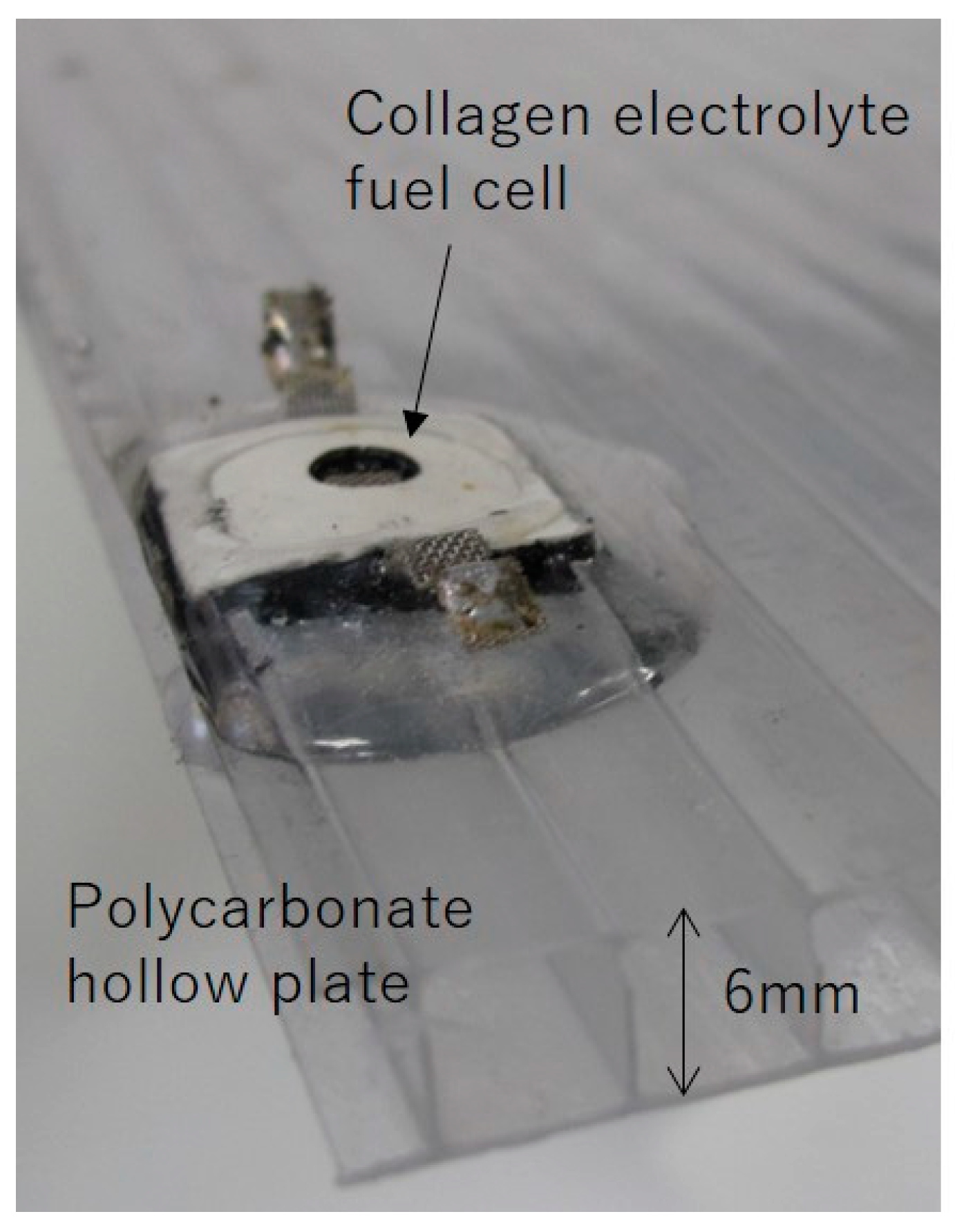
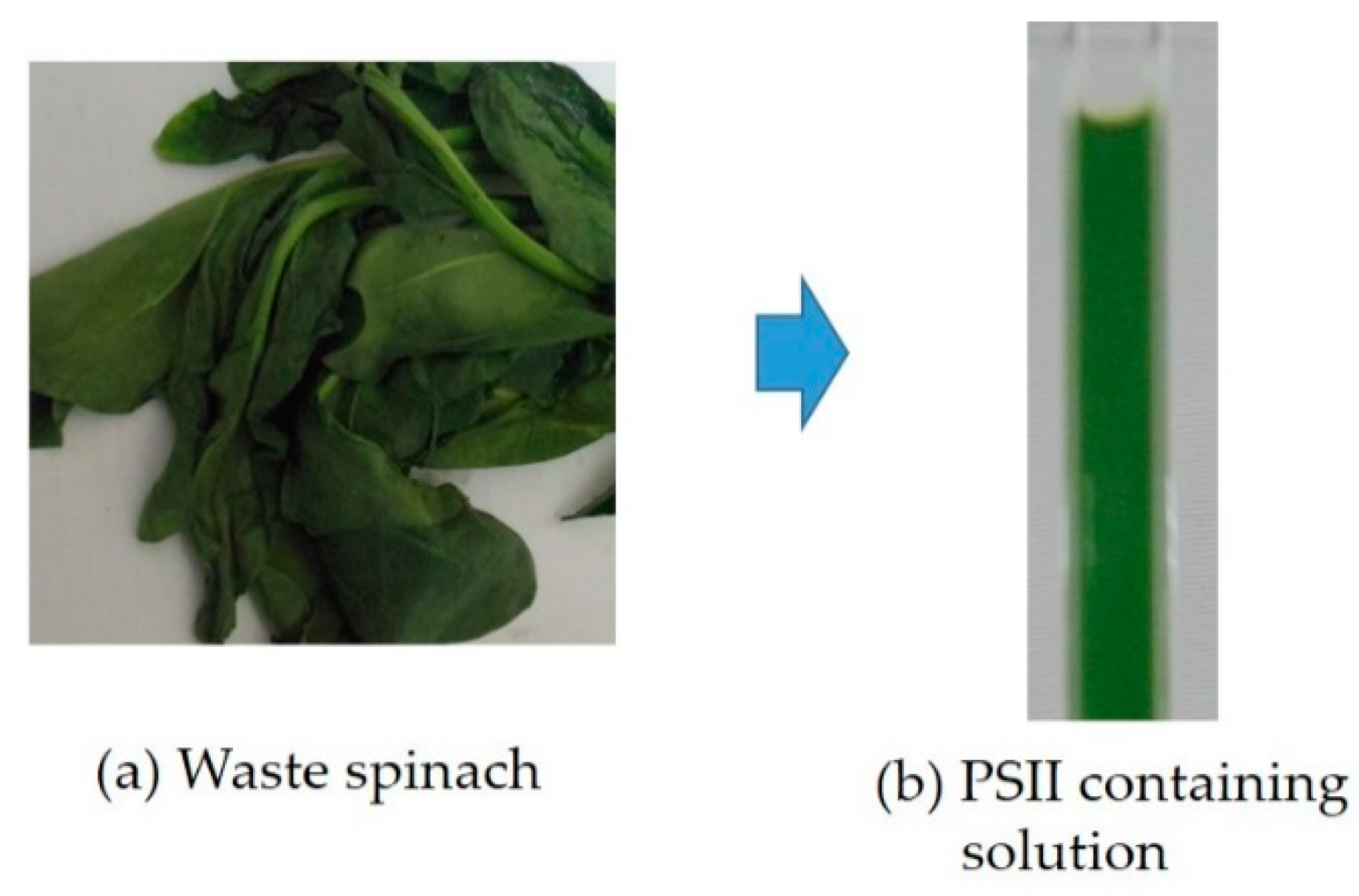

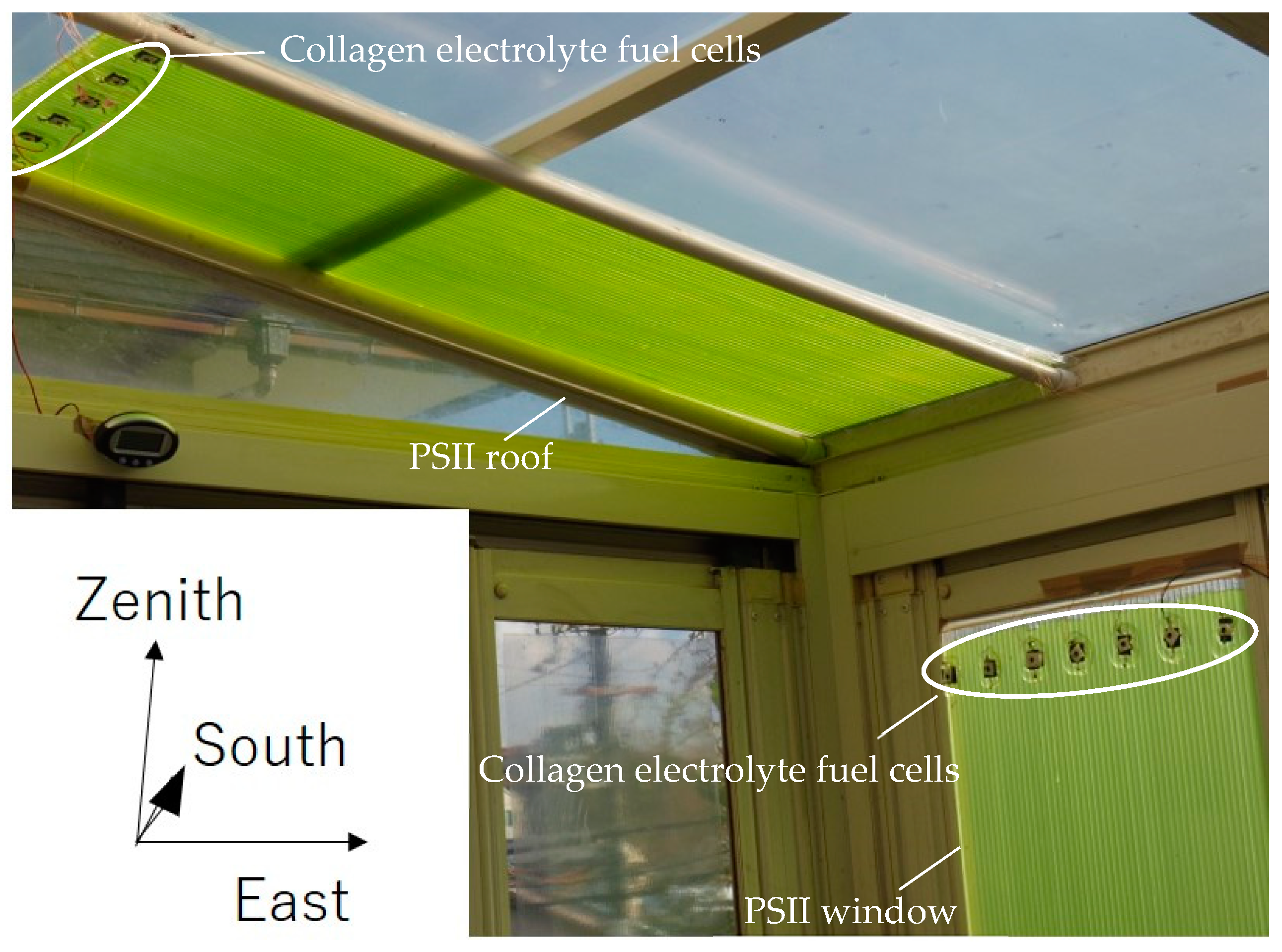


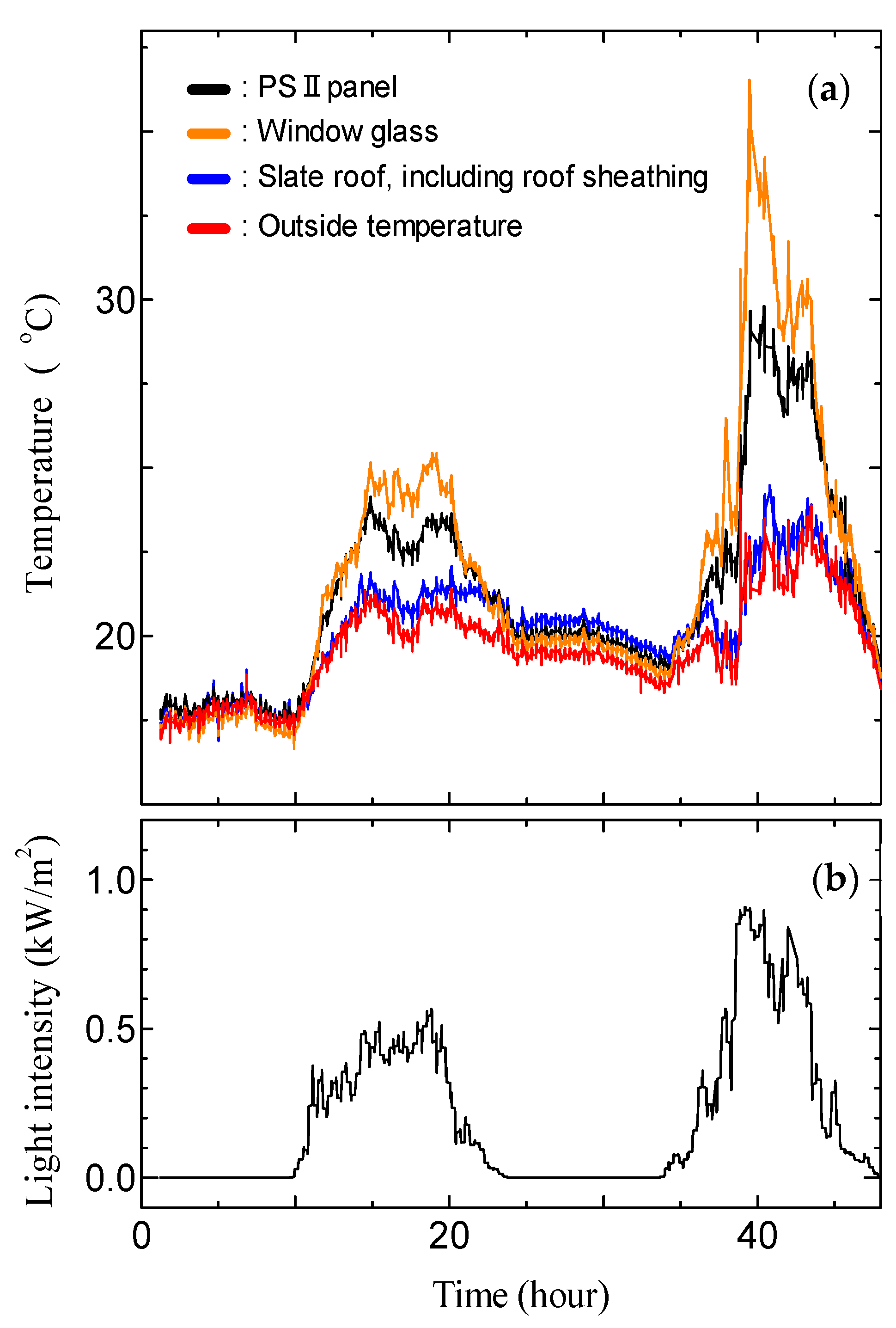
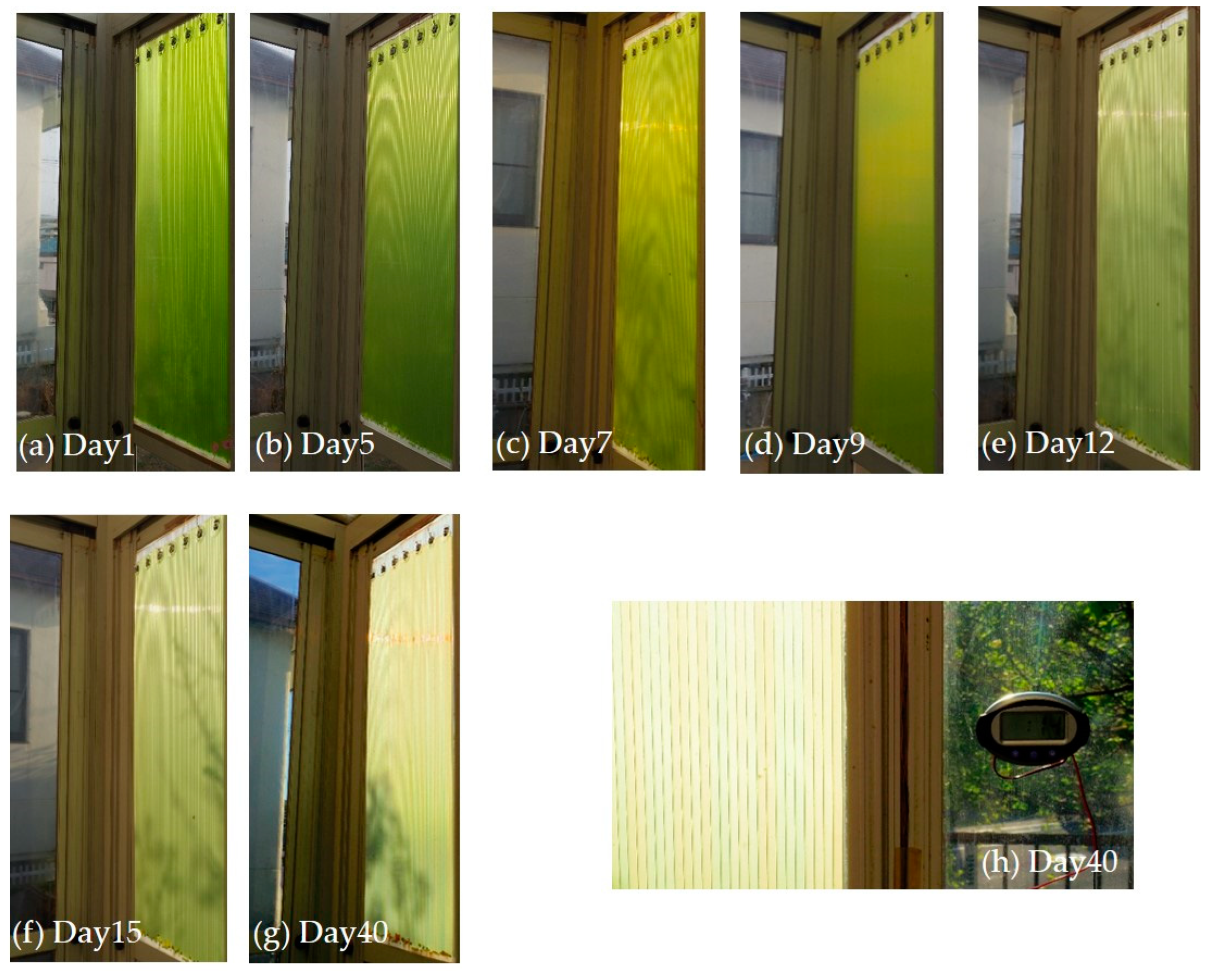
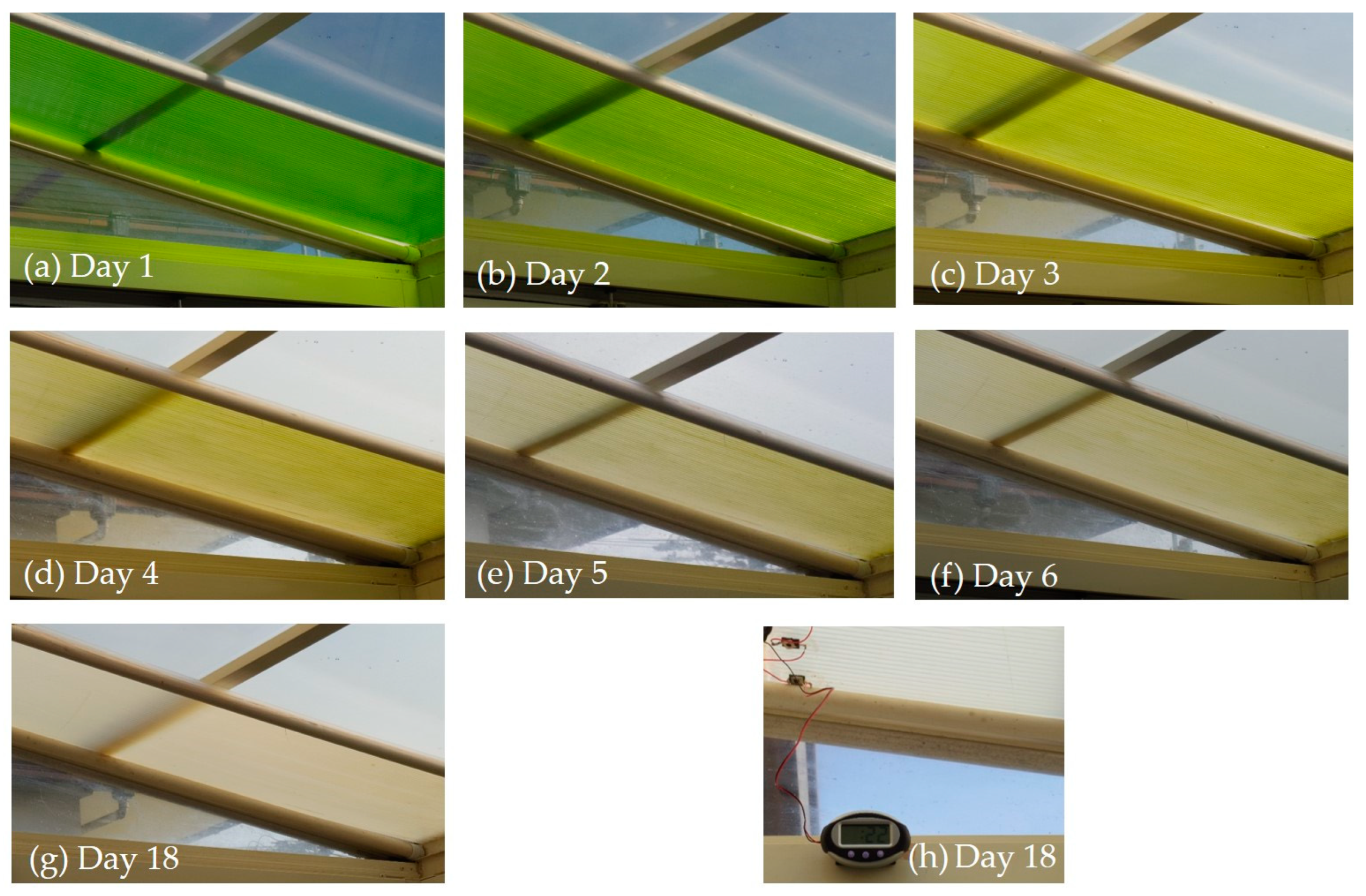
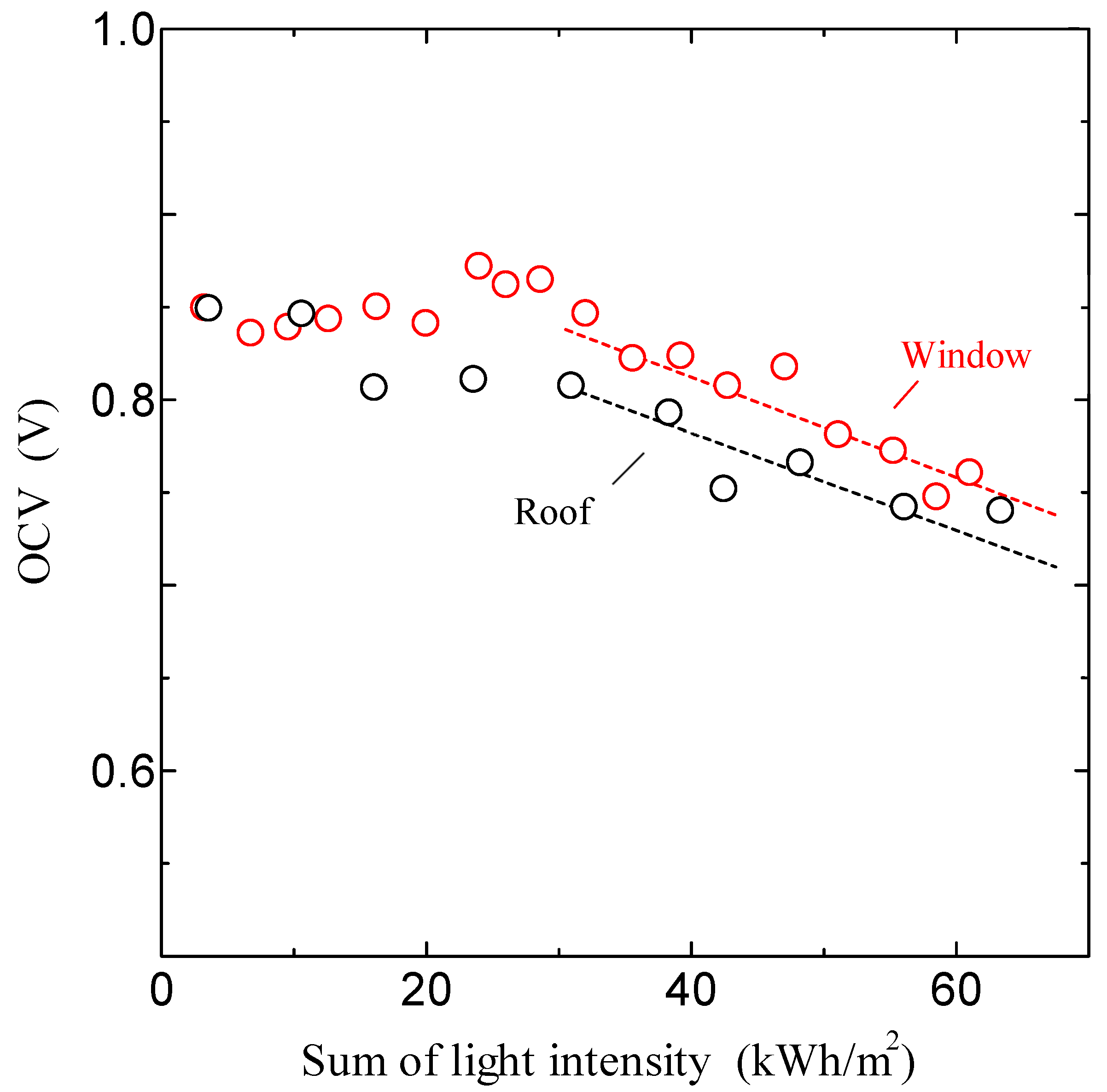
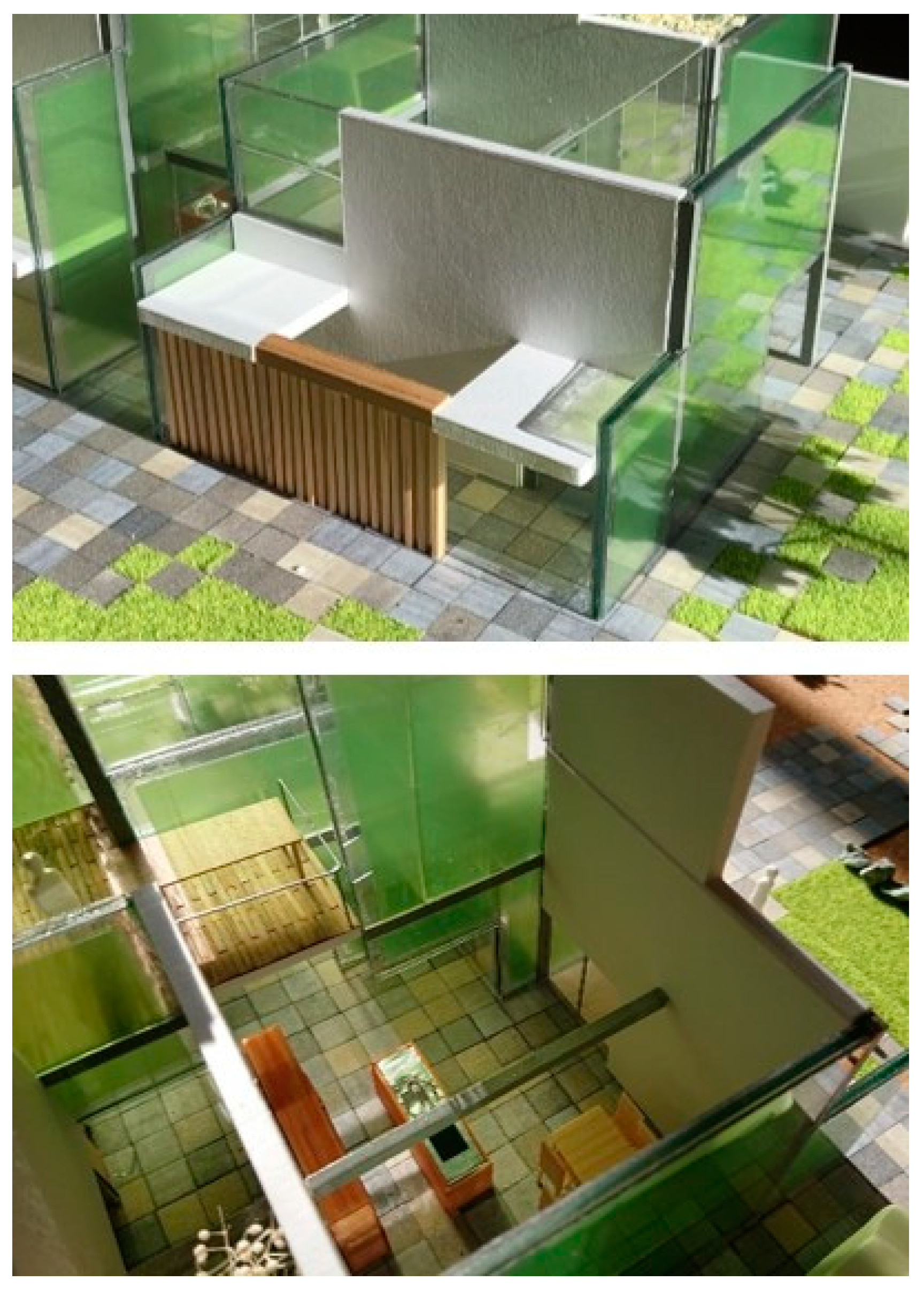
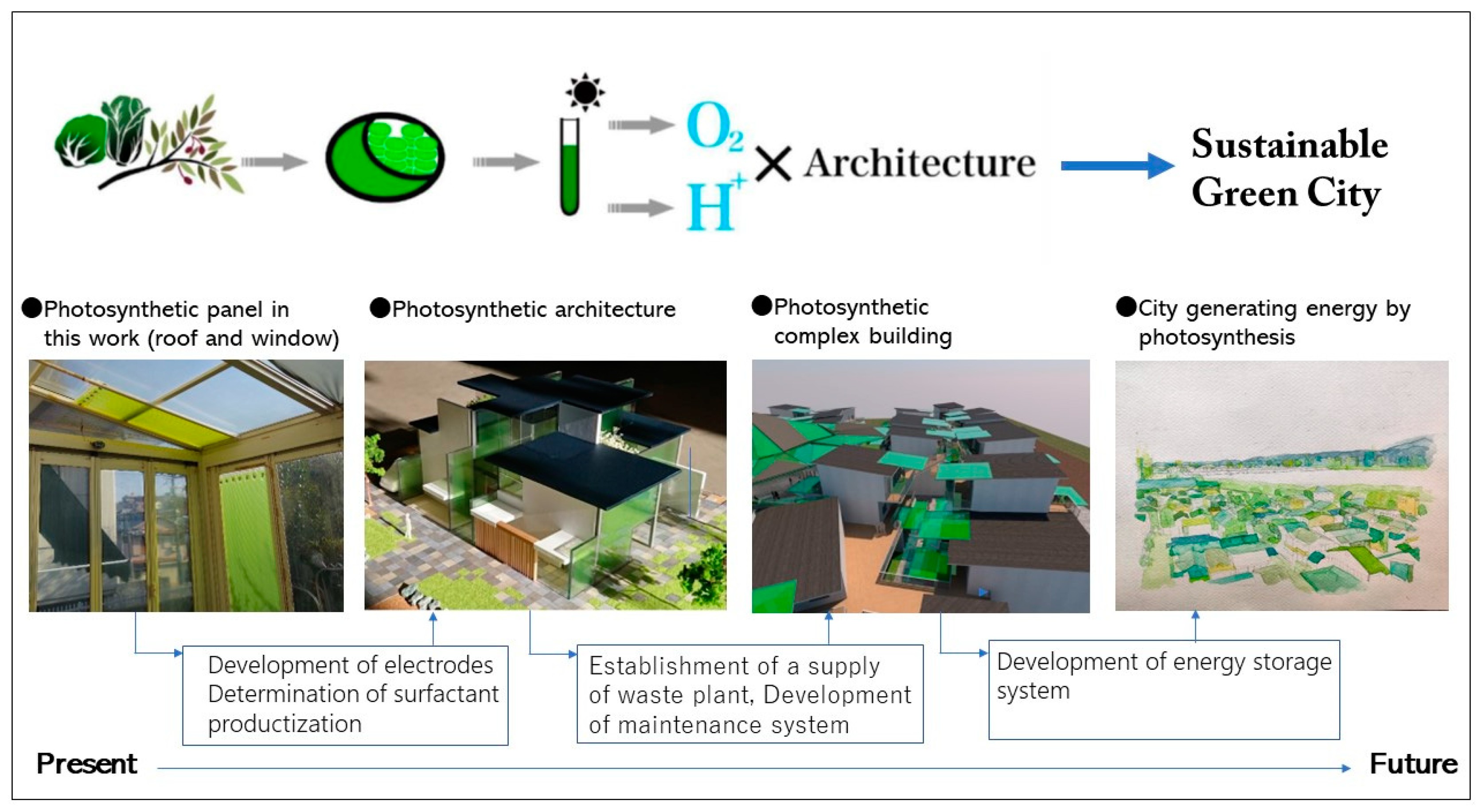
Publisher’s Note: MDPI stays neutral with regard to jurisdictional claims in published maps and institutional affiliations. |
© 2022 by the authors. Licensee MDPI, Basel, Switzerland. This article is an open access article distributed under the terms and conditions of the Creative Commons Attribution (CC BY) license (https://creativecommons.org/licenses/by/4.0/).
Share and Cite
Kawakami, H.; Matsuo, Y. Design of an Architectural Element Generating Hydrogen Energy by Photosynthesis—Model Case of the Roof and Window. Designs 2022, 6, 58. https://doi.org/10.3390/designs6030058
Kawakami H, Matsuo Y. Design of an Architectural Element Generating Hydrogen Energy by Photosynthesis—Model Case of the Roof and Window. Designs. 2022; 6(3):58. https://doi.org/10.3390/designs6030058
Chicago/Turabian StyleKawakami, Hinako, and Yasumitsu Matsuo. 2022. "Design of an Architectural Element Generating Hydrogen Energy by Photosynthesis—Model Case of the Roof and Window" Designs 6, no. 3: 58. https://doi.org/10.3390/designs6030058
APA StyleKawakami, H., & Matsuo, Y. (2022). Design of an Architectural Element Generating Hydrogen Energy by Photosynthesis—Model Case of the Roof and Window. Designs, 6(3), 58. https://doi.org/10.3390/designs6030058




